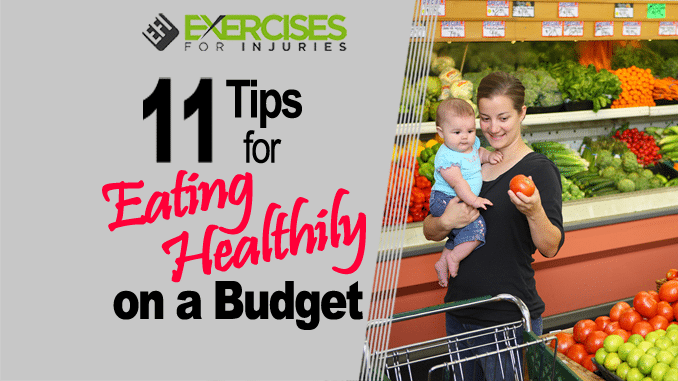
Eating healthy and nutritious foods is the most important thing you can do to improve your overall health and prevent disease. However, when you’re on a ramen noodle budget, can you afford organic produce and natural foods? Here are our 11 best tips for eating healthy on a budget.
1. It Doesn’t All Have to Be Organic
While we know that common pesticides used in conventional produce farming include chemicals that are linked to cancer, nervous system toxicity, hormonal imbalances and lung irritation, buying only organic produce can be expensive.
The Environmental Working Group (EWG) knows how difficult it can be to afford a grocery cart full of purely organic produce. So, they publish annual lists of the “Clean Fifteen” and the “Dirty Dozen” on its website. Basically, these two lists provide a guide to the 15 fruits and vegetables that have been shown to possess the least amount of pesticide residue and the 12 that are covered with the most toxic pesticides. Did you know that sweet corn and avocados rank among the cleanest conventionally grown produce varieties you can buy at the market? Pineapples, cauliflower and grapefruit also made the list.
When you find products on the clean list, don’t be afraid to stock up. Be aware of the “Dirty Dozen” too. Save room in your budget for organic or pesticide-free strawberries and spinach. The EWG warns that conventionally grown strawberries, spinach and nectarines (tested after washing) contain more pesticide residue than any other common produce.
Pro tip: Copy the EWG’s “Clean Fifteen” and “Dirty Dozen” lists onto a small piece of paper and store it in your wallet for easy access to the market. Alternatively, bookmark the EWG website on your smartphone before your next trip to the market.
2. Support Your Local Farmers
It’s almost always the best deal to buy your produce at the farm where it’s grown. If you live near any sort of produce farm, check to see if they run a farm stand on certain days of the week. Another option for buying from local farms is a widely known program called community-supported agriculture (CSA). Many farms offer members in the local community an opportunity to buy a share of their harvest each year or each season. In exchange for purchasing a share, a person can either pick up a weekly box of in-season produce from the farm or a nearby drop point. A CSA box full of fresh-picked fruits and vegetables is generally much less expensive than buying produce at the supermarket. You’ll be able to support farms that offer pesticide-free or organic produce as well. Check online to find CSA programs in your area.
Pro tip: Sign up for a full annual share to get the best CSA prices. Also, check to see if it’s cheaper to pick your own produce at the farm. Some farms also offer special discounts to patrons who volunteer during harvest times.
3. Plan Your Weekly Meals
The thought of planning out each meal and snack for the week, before you go shopping, may sound like a tedious time drain. But, in reality, weekly meal planning can not only save you money at the market but time as well.
Here’s how meal planning works. Get a pad of paper and stand in front of your open refrigerator. Look for perishable items that need to be used and list them. Do the same with items in your freezer and pantry. Once you have a good list of the ingredients you have on-hand, make a plan for breakfast, lunch, dinner and snacks for each day of the coming week. Include packed lunches for work, school or outings in your plan. Finally, make your grocery list by writing down the items you need to follow your plan.
Once you get into the habit of meal planning, you’ll realize that the practice saves you time each day when you don’t have to decide what to cook or make a last-minute trip to the market for an ingredient you need. You’ll also be buying less at the market when you’re making a solid effort to use up the food you already have at home.
Pro-tip: Use the grocery store sale papers for ideas as you plan your weekly meals.
4. Hit the Grocery Clearance Aisles First
Tips for eating healthy on a budget: Often, the markdown section of the grocery store is loaded with organic and natural foods. Why? Because the original price for those items is generally so high that most consumers pass them up. When the expiration date is approaching, grocers will cut the prices drastically to sell them before it’s too late.
With your grocery list in hand, head to the clearance aisles first to see if anything you have planned to buy happens to be marked down. You may find some ridiculously good deals on the clearance racks.
Pro tip: Ask the store manager what days and times they usually mark down their inventory. Often, the bulk of the markdowns are done weekly.
5. Buy What’s in Season
I’ve seen organic strawberries on sale for as little as $1 per pound in June, and organic grapes are much less expensive in the fall. When you can, opt for seasonal produce to save big.
Pro tip: When you find an amazing seasonal produce deal, buy as much as you can afford, and then wash, chop and freeze the rest for use later on in the year.
6. Buy Frozen Produce
When the price of fresh organic produce is through the roof, check the frozen aisles for deals. Frozen produce is not only cost-effective (most of the time) but farmers generally allow the produce to ripen on the tree or vine a bit longer when it’s going to be frozen, making frozen produce a healthy and tasty option.
Pro tip: Compare price-per-ounce of frozen vs. fresh produce to make sure you’re getting the best deal.
7. Buy Cheap Protein
Tips for Eating Healthy on a Budget: Steak and shrimp might be fantastic for special occasions but it’s not easy on the weekly grocery budget. Whole eggs, beans and chicken are cheaper sources of protein.
Pro tip: Eggs aren’t just for breakfast. Consider working them into your dinner plans a few times a week to make your meals more affordable.
8. Drink Cheaply
Tips for Eating Healthy on a Budget. If you need caffeine to get up and go, consider tea over coffee. It’s cheaper to buy a box of 100 organic tea bags than to buy 100 servings of organic ground coffee. Otherwise, stick to water when you’re thirsty and some form of milk or fortified orange juice for calcium, if you don’t get it elsewhere.
Pro tip: Buy a good quality water filter to purify your water at home instead of buying bottled water.
9. Stay on Your List
Tips for Eating Healthily on a Budget: It’s easy to get derailed when you’re shopping. However, if you’ve got a good list of what you know you’ll need for the week, trust the list and stay on it. Be intentional in the store. Walk only to the items you need rather than beginning at one end and browsing through the aisles until you reach the checkout stand.
Pro tip: When you make your grocery list, snap a picture of it with your phone. Then, if you lose it (or forget it on the counter), you’ve got a backup while you shop.
10. Stay Out of Boutique Natural Food Stores
It used to be difficult to find organic and natural foods. Those of us who didn’t want to eat packaged junk and sprayed produce had to seek out specialty grocery stores and pay up. Thank goodness that has changed. Big discount superstores have organic produce and natural foods sections. Warehouse giant Costco has actually become the largest organic foods retailer in the United States, passing up all the boutique natural food stores. Stretch your grocery dollars by shopping around for the store in your area with the best prices on natural foods.
Pro tip: Don’t always assume the big warehouse store has the best price. Compare price-per-ounce at the wholesale club just as you would at your local market.
11. Get Store Loyalty Cards and Sign Up for Email Alerts
Tips For Eating Healthily on a Budget: My local chain grocery store has a loyalty card. When I use the card, of course, I get the sale price. However, the store also tracks my purchases and sends me coupons for items I buy often. Score.
It took me a while to decide to link my loyalty card with their online savings center. However, when I finally did it, I was amazed at how much more money I started saving on the organic and natural foods I buy. Now, my store sends me email alerts, bonus digital coupons that are loaded onto my loyalty card and paper coupons through the mail.
Pro tip: Combine manufacturer’s coupons with loyalty card savings to get even bigger discounts.
Eating Healthy Doesn’t Have to Break the Bank
It isn’t impossible to eat nutritiously dense foods when you’re on a tight budget. It just takes some forethought and a solid game plan. Use our tips to get the most bang for your buck when you’re shopping for healthy foods.
For your guide to the best foods to heal your body, check out The Best Foods that Rapidly Slim & Heal in 7 Days, here!






